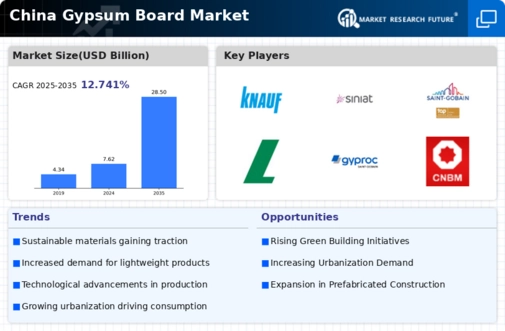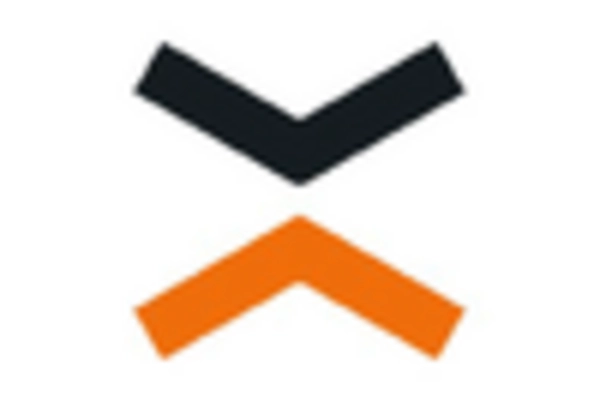Increasing Urbanization
The rapid urbanization in China is a pivotal driver for The Gypsum Board Market. As urban areas expand, the demand for residential and commercial buildings surges, leading to a heightened need for construction materials, including gypsum boards. In 2025, urbanization rates in China are projected to reach approximately 65%, which translates to millions of new housing units and commercial spaces requiring efficient and cost-effective building solutions. Gypsum boards, known for their lightweight and fire-resistant properties, are increasingly favored in modern construction. This trend indicates a robust growth trajectory for the gypsum board market, as urban developers and contractors seek materials that meet both aesthetic and functional requirements. The ongoing infrastructure projects further amplify this demand, suggesting that the gypsum board market will continue to thrive in the context of China's urban development.
Rising Construction Activities
The resurgence of construction activities in China is a primary driver for The Gypsum Board Market. With the government prioritizing infrastructure development and urban renewal projects, the construction sector is experiencing a significant boost. In 2025, the construction industry is projected to grow by approximately 8%, leading to an increased demand for building materials, including gypsum boards. This growth is particularly evident in tier-one and tier-two cities, where new residential and commercial projects are underway. The versatility and ease of installation of gypsum boards make them a preferred choice among contractors and builders. As construction activities ramp up, the gypsum board market is likely to benefit from the heightened demand, positioning itself as a key player in the evolving landscape of the construction industry.
Government Initiatives and Regulations
Government policies and regulations play a crucial role in shaping The Gypsum Board Market in China. The Chinese government has implemented various initiatives aimed at promoting sustainable construction practices and enhancing building safety standards. For instance, regulations mandating the use of fire-resistant materials in public buildings have led to an increased adoption of gypsum boards, which are recognized for their fire-resistant capabilities. Additionally, the government's focus on energy efficiency and environmental sustainability encourages the use of gypsum boards, which are often produced with lower environmental impact compared to traditional materials. As these regulations evolve, they are likely to create a favorable environment for the gypsum board market, driving innovation and compliance among manufacturers. The anticipated growth in the market could be further supported by government incentives for green building practices.
Technological Innovations in Production
Technological advancements in the production of gypsum boards are significantly influencing the market landscape in China. Innovations such as automated manufacturing processes and improved raw material sourcing have enhanced production efficiency and product quality. In 2025, the introduction of advanced machinery and techniques is expected to reduce production costs by approximately 15%, making gypsum boards more accessible to a broader range of consumers. Furthermore, the development of specialized gypsum boards, such as moisture-resistant and soundproof variants, caters to diverse consumer needs, thereby expanding the market. These technological innovations not only improve the performance characteristics of gypsum boards but also align with the growing demand for customized building solutions. As manufacturers continue to invest in research and development, The Gypsum Board Market is poised for sustained growth, driven by enhanced product offerings and competitive pricing.
Growing Awareness of Health and Safety Standards
The increasing awareness of health and safety standards among consumers and builders is driving The Gypsum Board Market in China. As construction practices evolve, there is a growing emphasis on materials that contribute to indoor air quality and overall safety. Gypsum boards, which are non-toxic and contribute to healthier living environments, are gaining traction among environmentally conscious consumers. In 2025, it is estimated that the demand for low-VOC (volatile organic compounds) building materials will rise by 20%, further propelling the gypsum board market. This trend is indicative of a broader shift towards sustainable building practices, where health and safety considerations are paramount. As awareness continues to grow, manufacturers are likely to adapt their product lines to meet these emerging standards, thereby enhancing their market position.

















Leave a Comment